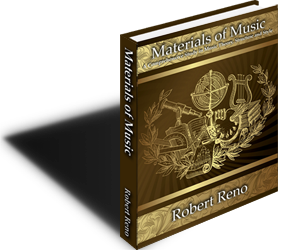Get a University Level Music Education at Home with
 Materials of Music
Materials of Music
A superb music skills book by Robert Reno created to help music students become better musicians!
Every great musician I know is working on their music knowledge and moving their music skills forward.
Most continue to learn applied music theory and application to better their composition, arrangement, and understanding of music structure.
This skills book, with worksheets and audio, is a new downloadable e-book to help you become that better musician.
Introducing Materials of Music
 I want to introduce you to Robert Reno and his great music skills book.
I want to introduce you to Robert Reno and his great music skills book.
Bob is a composer, arranger, pianist and teacher and a contributor here at Music Learning Workshop and we are proud to champion this volume of work.
“Materials of Music” was conceived as as a two year, university level, text book. It was developed, tested, used, and proven in the classroom over several years.
Yet it is organized, illustrated, and expressed in easy straight forward language for any musician with a desire to learn how music works.
“Materials of Music” takes the student on a journey from the foundational principles to some remarkably sophisticated lessons including melodic principles, four-part harmonization, and modulation. All while keeping it clear and easy to follow.
We’re proud to promote this as an excellent addition to your music study.
Starting with the Fundamentals of Music Theory
When studying fundamentals of music, the theory is actually fairly simple, but it takes time to pull the parts together in a coherent set of rules.
In doing so you establish the basic abilities to read notes, rhythm, scales, and chords. Then exploring harmonic systems. This is what the music course here at the Music Learning Workshop does.
Bob’s approach and organization is based on similar building techniques. He approaches the foundations quickly in the first quarter of the material and moves into diatonic harmony and chromatic harmony dealing with these subjects and adding in the necessary expansion of the basic principles to augment the sections.
I really appreciate this approach as the essence of harmonic systems is where music and music theory get really exciting and where you as the musician become an artist.
Let’s exam a little closer some of the subjects and lessons you will study.
Materials of Music – Subjects and Sections
This book is organized into three study categories and added appendices with support information. In addition there are separate worksheets and audio files to use with each lesson.
Bob begins by stating: “All music contains, at least to a certain degree, pitch, time, texture, dynamics, timbre, form and style.” to begin this course material. That’s spot on! And a great place to get started.
The 3 main sections cover a total of 37 chapter/ lessons with exercises, they are:
- Fundamentals of Music
- Diatonic harmony
- Chromatic Harmony
The appendices include:
- a keyboard diagram,
- blank manuscript paper,
- accompaniment patterns,
- transposing instruments, and
- a comparative style table.
Part 1 – Fundamentals of music
AT MLW, our fundamentals course is a heavy handed, interactive, get it down cold, build your own theory book approach and it takes us 10 times as many pages to cover the fundamental music elements based on the home study learning techniques we use.
Materials of Music address the principles quickly yet thoroughly and uses exercises to learn these principles. Each topic is explained clearly and concisely, and is accompanied by numerous examples from the standard repertory.
In part 1, you cover the basic definitions that were stated above. You’ll get a good understanding of notation, pitch reading, intervals, major scales, minor scales, key signatures, understanding music time (rhythm), triad & seventh chords, chord inversions, and figured bass (which is something we don’t cover in our course).Part 2 – Diatonic Harmony
You hear harmony thrown around all the time. Well, this part of the skills book is going to give you a great understanding of diatonic harmony.
These music lessons start out with an introduction to harmonic analysis and right into diatonic harmony. This is the where music will start to come together for you.
Fundamentals cover the basics and provide the basis of systems and how to create them. This is where the advanced theory happens and you get into what scale degrees and harmony really mean.
As you continue, you cover lessons on cadences, melodic principles, four part writing, progressions, and melody harmonization.
The last 5 lessons address chord inversions, non-chord tones, and seventh chords in the harmonic structure.
Part 3 – Chromatic harmony
Chromatic harmony deals with the pitches or notes outside the of a given key signature or scale. This gives rise to what is known as the altered harmony and chords. Now were cooking with gas! It almost sounds scary.
Bob has broken this section down into 14 lessons and starts with secondary dominants, secondary leading tones, tonal cells and modulation to nearby keys.
The next lessons deal with a lot on form and include choral harmonization, two great chapters on musical form, mode mixture.
After that you get to come back to chords and learn about two types of sixth chords, more on modulation to distant keys, extended tertian chords (yes the jazz chords!!!!), an examination of diminished 7ths as a embellishment harmony, and altered dominates (playing with the fifth).
This section pushes you to the limit and ends with chromatic linear harmony, post romantic harmony and caps it off with modern musical materials.
Summary Materials of Music
Now that’s a boat load of stuff to learn, like two years worth of college study. Here’s the neat thing about the lessons. They are relatively short, no more than a few pages. That means you can study them in detail in a short period of time.
However, applying what you learned will take time and it will be time well spent. This is a remarkable collection of lessons that should be used and studied. Several of the lessons in the beginning can be done in quick order. Others will take more time to absorb and master.
The amount of stuff covered here can cost thousands of dollars when taken at college or even privately. This resource is of great value.
Think of it this way, you can get three college level lessons for the for less than a fancy coffee drink or adult beverage at the local watering hole.
Get Materials of Music
MLW is excited to be able to offer this great resource directly.
The music skills book,“Materials of Music” is $39.95,
which is a completely indexed PDF formatted file, with separate printable worksheets and mp3 audio files.
Get it for immediate download here:
Authorized reseller Music Learning Workshop and Chidester Enterprises LLC.
Here’s to you mastering music,
Music Learning Workshop
P. S.: Bob is a contributor here at Music Learning Workshop and we are proud to champion this volume of work.
P. P. S.: Do you can gain as much as a college student by taking the time to utilize a specific text like this at a fraction the cost of private or university lessons. It’s knowing and studying the fundamentals of music and the harmony concepts that get you beyond the note by note playing and into owning the music.
To Your Success!

